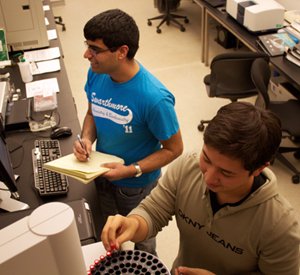Two Biochemistry Majors Ask: How Much Cocaine Is in Your Wallet?
Two Biochemistry Majors Ask:
How Much Cocaine Is in Your Wallet?
by Alisa Giardinelli
2/22/2012

How much cocaine is in your wallet? Ray Alfaro-Aco '12 and Vishaal Chhabria '13 used the occasion of a research project in Chem 43 to find out.
"The idea came when we read a CNN report claiming that 90 percent of all bills in the country have trace amounts of cocaine on them," says Alfaro-Aco, a biochemistry major from Lancaster, Pa., by way of Mexico. "We decided to test bills from this area against that reported average."
"The way we collected the money was kind of fun," admits Chhabria, a pre-med student from Stroudsburg, Pa. "One day during lab we walked 10 miles in Philadelphia, asking for change or buying something small from, say, a barbershop on South Street, some food carts in University City, and other spots in Chinatown and Old City."
They ultimately obtained and then tested 36 bills, a sample bigger than those used in some of the published studies they consulted for reference. To extract the cocaine from each one, they submerged it in methanol, which dissolves cocaine. The methanol containing the dissolved cocaine was then made more concentrated and inserted into the department's gas chromatography mass spectrometry device, which provided a qualitative analysis indicating the presence of cocaine, as well as the quantitative amount of cocaine present.
"I personally expected to find cocaine," Chhabria says. "Ray was doubtful, and surprised when we did."
In fact, they found that all but one bill had cocaine, with most having between zero and 25 micrograms. One bill even had 120 micrograms, leading Chhabria to theorize that it had been "next to a primary source of usage in someone's wallet." Perhaps not surprisingly, they discovered, that, along with cocaine, dollar bills are also contaminated with various food oils, oils used in soaps and cosmetics, acetamenophin (Tylenol), and bisphenol A (BPA). Their findings are presented in this poster (pdf).
In Chem 43, taught by Assistant Professor of Chemistry Alison Holliday, the goal is not just to learn analytical chemistry, but also how to design experiments, devise the sampling, and analyze the results. Within those parameters, students are limited only by what experiments they can imagine. Students in Alfaro-Aco and Vishaal's class chose to examine for their research topics levels of urea in the College's pool, gluten in Sharples food, dye in Gatorade, and BPA in canned soup, among others.
"Professor Holliday was our primary mentor," Alfaro-Aco says. "We worked with her throughout the entire project and her feedback is what allowed us to move forward successfully."
Chhabria and Alfaro-Aco also credit lab instructor Caroline Burkhard and instrument coordinator David Trimble for their "invaluable support" throughout the project. For Chhabria, perhaps the most memorable moment in class came halfway through it. "That's when," he says, "Professor Holliday said, 'This is where normal analytical chemistry courses end.'"


